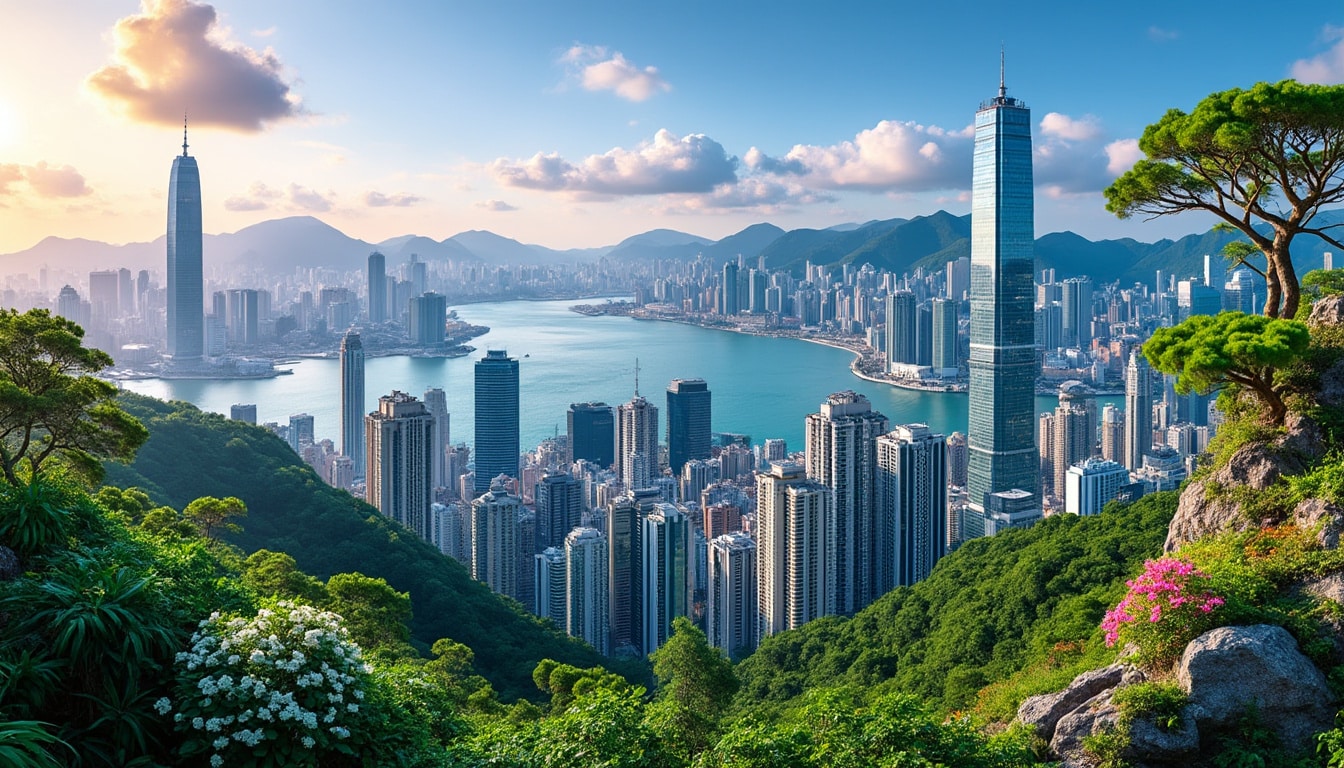Hong Kong is renowned for its stunning blend of urban sophistication and natural beauty. While globally recognized for its iconic skyscrapers and bustling city life, the natural and geographical landscape of Hong Kong offers an explorative journey into lush greenery, diverse ecosystems, and unique geological formations. This article delves into these contrasting aspects, exploring how they coexist within this vibrant metropolis, creating a remarkable urban jungle that is as much a haven for nature lovers as it is for city dwellers. From its mountainous terrains to its extensive coastline, Hong Kong is a remarkable tapestry of nature’s palette that invites exploration.
The Geography of Hong Kong: A Unique Blend of Urban and Rural Landscapes
Hong Kong, officially known as the Hong Kong Special Administrative Region (HKSAR) of China, is situated at the southeastern tip of China. It comprises a complex of 235 islands including the larger regions of Hong Kong Island, the Kowloon Peninsula, the New Territories, and the Outlying Islands, which extend into the South China Sea. This intricate geographical network spans approximately 1,099 square kilometers, making it one of the most densely populated areas in the world.
Despite its urban density, over 75% of Hong Kong’s landmass is open countryside, consisting of lush green hills and protected nature reserves. These areas are largely distributed across the New Territories, which occupy about 91% of the total area. Hong Kong Island accounts for roughly 7%, hosting its vibrant business district, while the Outlying Islands contribute to about 20% of this region. Of these, Lantau Island is the largest, nearly twice the size of Hong Kong Island, known for its scenic landscapes and cultural significance.
Prominent landscapes include Mount Victoria, the highest point on Hong Kong Island, offering breathtaking views over the city’s iconic skyline. Lantau Island is home to Sunset Peak and Lantau Peak, both rising around 900 meters, providing extensive trekking opportunities on trails such as the Lantau Trail, which is a favorite among hikers. Meanwhile, Tai Mo Shan in the New Territories climbs to 959 meters, standing as the highest mountain in the region, often shrouded in mist and providing a lush haven of diverse flora and fauna.
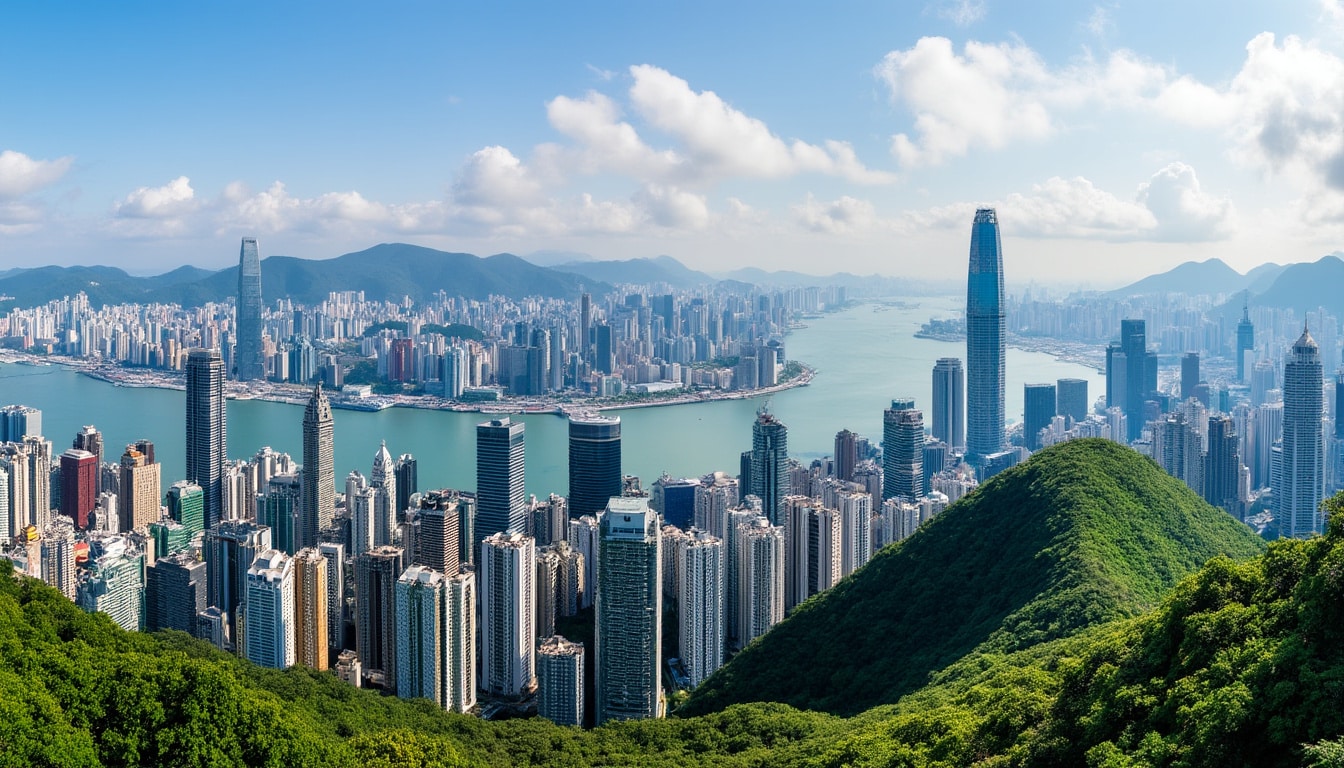
Merging Urban Infrastructure with Natural Landscapes
One of Hong Kong’s distinctive geographical features is how its urban architecture is seamlessly woven into its natural landscape. The city’s flourishing urban core — dotted with high-rise buildings and complex infrastructures — sits adjacent to expansive natural preserves. This juxtaposition is not merely aesthetic but is a testament to Hong Kong’s unique urban planning strategies, which emphasize coexistence and sustainability.
This careful balance is essential in a city where the demand for land is ever-increasing. Hong Kong’s urban development mitigates its ecological footprint through practices such as land reclamation and vertical high-density building strategies, which allow for preservation of natural parks and reserves. For instance, the use of green buildings is prevalent, integrating advanced technology aimed at reducing energy consumption and promoting eco-friendly lifestyles.
- 🌿 Victoria Peak Adventures offer panoramic views and access to nature trails.
- 🏞️ The New Territories feature expansive country parks.
- 🏝️ Lantau Island is known for its vast, breathtaking landscapes.
| Region | Percentage of Total Area | Notable Feature |
|---|---|---|
| Hong Kong Island | 7% | 🏙️ Vibrant business district |
| New Territories | 91% | 🌳 Extensive green countryside |
| Outlying Islands | 20% | 🏞️ Picturesque landscapes |
The Natural Ecosystems of Hong Kong: A Biodiversity Hotspot
Hong Kong’s natural ecosystems represent a convergence of varied habitats teeming with diverse flora and fauna. Its rich biodiversity is largely due to the region’s subtropical climate, which fosters a lush ecological environment. From mangroves to coastal shores, these ecosystems are vital not just for biodiversity conservation but also for sustaining the city’s ecological balance.
Mangrove ecosystems, predominantly found in areas like Deep Bay, are crucial habitats that support a wide array of species. These include various species of crustaceans and fish that thrive in the nutrient-rich environments. Mangrove trees are uniquely adapted to saline conditions, with their tangled root systems anchoring them in the muddy substrate, supporting a range of wildlife.
Coastal areas such as beaches and rocky shores in Hong Kong play a significant role in biodiversity support. Rocky shores, such as those found near Luk Keng and Cape D’Aguilar Marine Reserve, are habitat to sessile filter-feeding organisms and mobile herbivores and carnivores. These areas experience varying species populations depending on seasonal currents, exemplifying nature’s adaptability.
- 🌱 Over 2,600 vascular plant species are found in the region.
- 🦜 Hong Kong hosts around 450 bird species.
- 🦋 The diverse environment supports about 200 butterfly species.
In addition to coastal ecosystems, Hong Kong’s freshwater habitats, including rivers and streams like Wa Mei Shan and Lam Tsuen River, offer essential life-supporting resources for various aquatic species. These environments are characterized by their current variability and oxygen content, factors that significantly influence the type and adaptation of resident biodiversity.
The Challenges of Urbanization and Environmental Sustainability
Hong Kong’s rapid urbanization presents significant challenges to its natural ecosystems. The delicate balance between development and environmental conservation is often tested as the city attempts to expand its infrastructure. Pollution from industries and urban areas has led to deteriorating air and water quality.
This environmental degradation impacts both terrestrial and aquatic life, such as the endangered Chinese white dolphin and the black-faced spoonbill. Ongoing efforts are crucial to preserve these species, with conservation areas like the Mai Po Marsh recognized for hosting increasing populations of rare birds despite urban pressures.
- 🌳 Adoption of sustainable urban development practices.
- ⚠️ Conservation initiatives for endangered species.
- ♻️ Implementing pollution control measures.
| Challenge | Impact | Solution |
|---|---|---|
| Air Pollution | Decline in air quality | 🚴 Promote clean energy and transportation |
| Water Pollution | Harm to marine life | 🚫 Wastewater management systems |
| Urban Sprawl | Loss of green spaces | 👷 Green building codes and land-use planning |
Weather Patterns and Climate: Navigating Hong Kong’s Subtropical Climate
Hong Kong’s subtropical climate plays a pivotal role in shaping its natural environment, characterized by hot, humid summers and temperate, dry winters. This climatic regime is majorly influenced by seasonal monsoon winds and geographical factors.
Throughout the year, the city experiences distinct weather patterns. From late May to mid-September, the area is subjected to hot conditions with temperatures peaking above 30 degrees Celsius. Accompanying these warm spells is a significant amount of rainfall, with over 2,200 liters of rain per square meter falling annually, largely concentrated in these months.
These rainy periods are intermitted with typhoons and intense thunderstorms, posing challenges to the city’s infrastructure. Conversely, the cooler months from December to February bring mild, dry weather, providing a pleasant respite for both residents and visitors alike.
🌧️ Click here for further details on Hong Kong’s rain patterns.
Weather Resilience and Preparedness
Hong Kong’s ability to withstand and adapt to weather challenges is a key aspect of its resilience. The city’s infrastructure is designed to accommodate heavy rainfall and mitigate flooding risks through advanced drainage and sewage systems. In addition, urban planning incorporates wind vent corridors to enhance air circulation within densely populated areas.
📉 Learn more about Hong Kong’s flood management strategies.
- 🚀 Development of weather forecasting technologies.
- 🏢 Design considerations for typhoon-resistant infrastructure.
- 📜 Regulatory measures for climate adaptation.
| Season | Temperature Range (°C) | Weather Conditions |
|---|---|---|
| Summer | 28-33 | 🌞 Hot and humid with thunderstorms |
| Winter | 15-21 | ❄️ Cool and dry |
Conservation Efforts: Towards a Sustainable Green Horizon
Amidst its rapid urbanization, Hong Kong has made significant strides towards environmental sustainability, focusing on conservation as a key element of its urban development strategy. These efforts are essential in maintaining the balance between urban life and the natural environment, ensuring a healthier and more sustainable future.
Numerous initiatives are in place to bolster ecological preservation efforts. The establishment of country parks and nature reserves occupies about 40% of the total land area, serving as crucial biodiversity havens. These protected areas support a wide range of ecosystems and species, including many that are native and endemic to the region.
Furthermore, public awareness and involvement in ecological conservation have been actively promoted. Education programs and community-driven projects aim to foster a deeper connection and commitment to the environment among Hong Kong’s residents, reinforcing the importance of maintaining ecological integrity amidst urban expansion.
🌍 Join the movement for a greener Hong Kong.
Future Outlook: Sustainable Development Goals
As Hong Kong looks towards the future, sustainability remains a critical component of its development agenda. The city’s plans emphasize integrating ecological considerations within its urban planning framework, striving to enhance green infrastructure and climate resilience.
🌱 Discover the sustainable urban planning initiatives in Hong Kong.
- 🔋 Promotion of renewable energy sources.
- 🏗️ Implementation of green buildings.
- 🗺️ Expansion of green transport options.
| Initiative | Area of Focus | Goal |
|---|---|---|
| Green Building Codes | Construction | 🏠 Enhance energy efficiency |
| Nature Reserves | Conservation | 🌾 Preserve biodiversity |
| Transportation | Mobility | 🚉 Reduce carbon emissions |
FAQs
What is the main geographical feature of Hong Kong?
Hong Kong’s geography is characterized by its mix of urban development and abundant natural landscapes, including mountains, country parks, and over 235 islands.
How does Hong Kong manage its environmental challenges?
The city tackles these issues through sustainable urban planning, conservation initiatives, and advanced infrastructure designed to withstand environmental impacts.
What are some key conservation areas in Hong Kong?
Numerous areas such as the Mai Po Marshes, country parks, and nature reserves serve as major conservation spots preserving Hong Kong’s rich biodiversity.
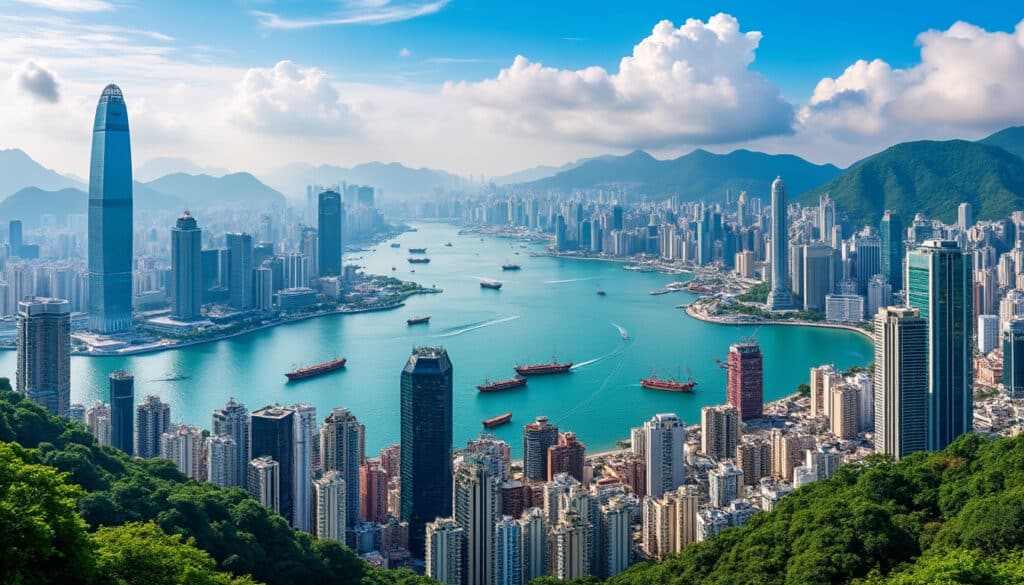
Geographical features of Hong Kong
Hong Kong, with its iconic skyline and bustling urban life, is more than just a vibrant metropolis. Its geography offers a unique blend of urban landscapes and natural beauty. From the towering peaks and lush islands to hidden bays and…
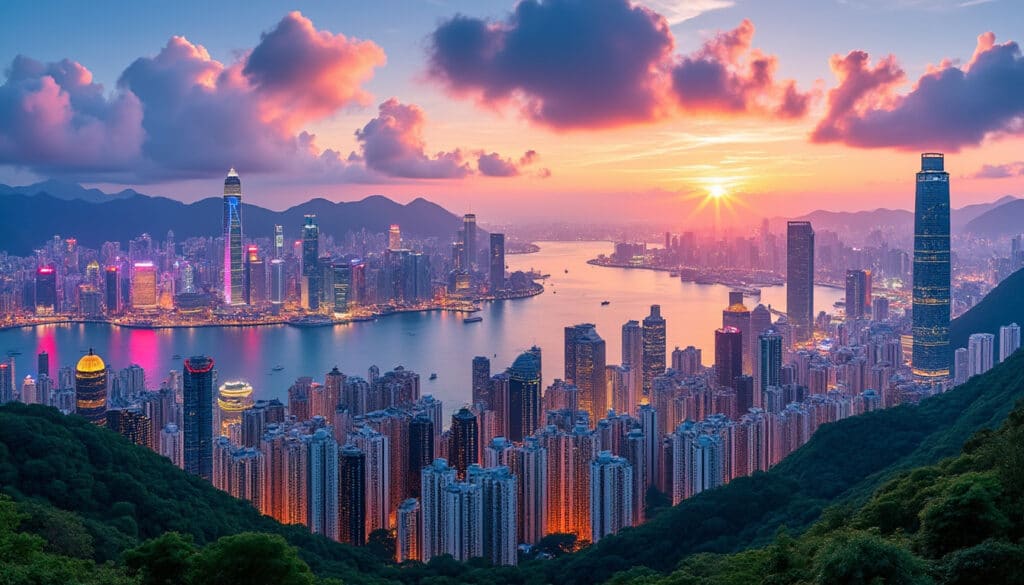
Location and coordinates of Hong Kong
Understanding the geographical position of Hong Kong is key for visitors and residents alike, especially in a city that is as dynamic and intricate as this. Whether planning a new adventure, finding the best travel routes or exploring significant landmarks,…
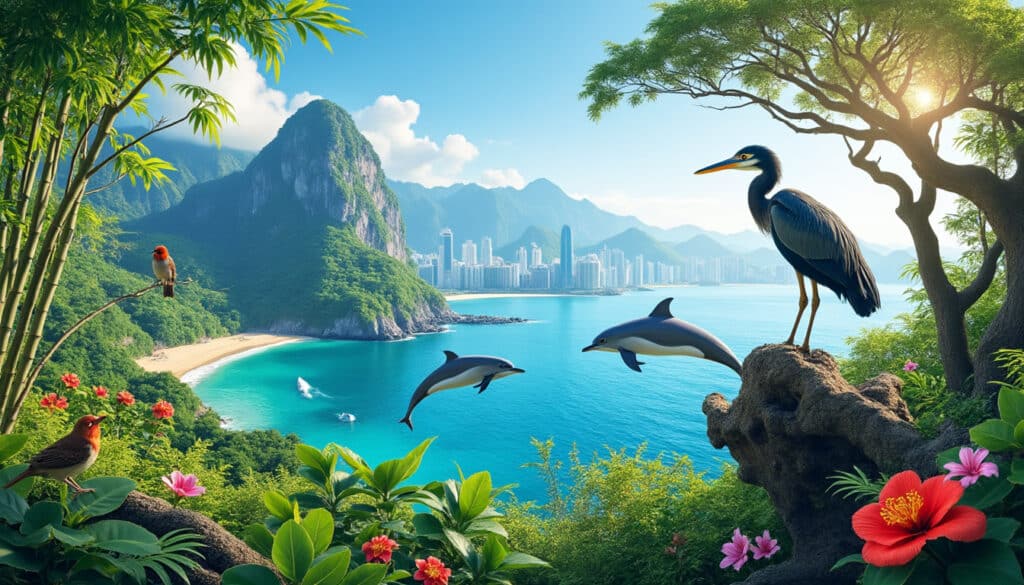
Nature and wildlife in Hong Kong
Hong Kong, known for its bustling streets and towering skyscrapers, hides an enchanting world of nature and wildlife that many might overlook. This city, often referred to as Asia’s World City, boasts a rich tapestry of biodiversity, embracing everything from…
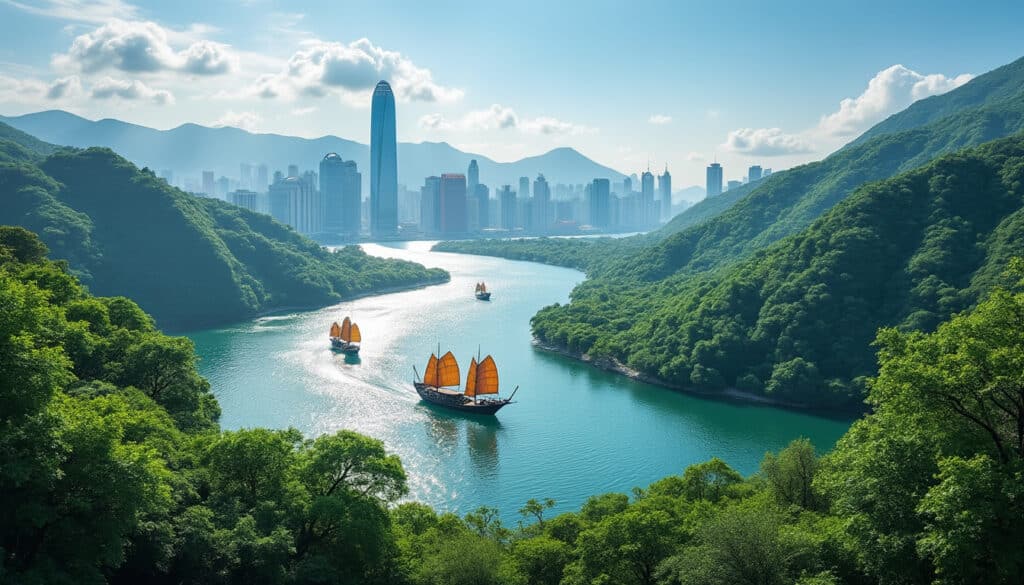
Rivers and water near Hong Kong
Hong Kong’s unique geographical makeup, dominated by an array of rivers and waterways, paints a vibrant picture that is often overshadowed by its bustling urban core. Tucked between hilly terrains and urban expansions, these river systems offer a crucial insight…

